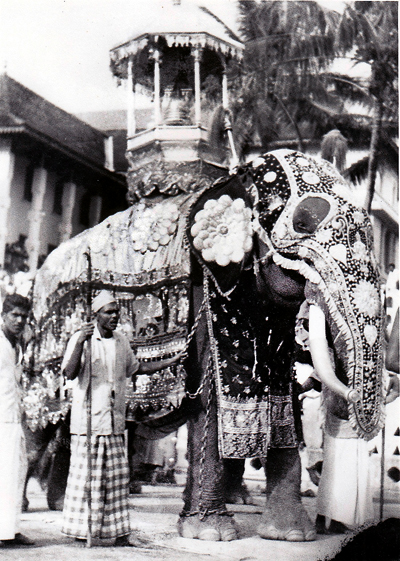Beloved Raja who swayed to the beat of the ‘gajaga vannama’
It’s been 30 years since the loss of our most magnificent Raja, the Maligawa Tusker. On July 18, 1988 the whole country mourned the death of Raja. Raja was loved by all citizens of this country and he was famous even internationally. He became the image of our heritage for he performed the noble duty of carrying the Sacred Relics of the Buddha, in the most colourful religious pageant in the world. He performed this noble duty continuously for 40 plus years in the Kandy Esala Perahera.
In his day, Raja was definitely the most majestic tusker one could hope to see, the centre of attraction, performing his duty magnificently caprisoned in the jewel-studded costume, his

Raja parading the streets of Kandy
glittering ivory sheathed in gold and decorated with jasmine garlands swaying gently in a rhythmic walk to the tune of the Gajaga vanama. It was a glorious sight indeed. Raja was flanked by Kanda and another tusker, all beautifully adorned. It was the wish of all who witnessed the perahera to see Raja and the others walk the fire torch-lit streets of Kandy with hundreds of drummers and dancers. Raja would probably have been the most illustrated and photographed tusker in the world.
Tuskers Raja and Kanda became the possession of the Sri Dalada Maligawa when Tikiri Banda Mampitya Disawa of Giragama Walauwa in Pilimathalawa, (Disahamuduruwo as he was respectfully addressed by his people) decided suddenly to donate Raja along with his lifelong companion Kanda to perform the noble duty of carrying the Sacred Relics at the Kandy Esala Perahera. The Maligawa was then dependent on private elephant owners to send a tusker or two for this grand ceremony. The two tuskers were the Disawa’s prized possessions, playfully roaming his estate at Giragama. Going down to the river for a daily bath was the only time they left the premises of the walauwa. The Disawa had purchased the two young tuskers on December 11, 1925 from a merchant named Ummeru Lebbe who had captured them in the jungles of eastern Sri Lanka under a government licence No. 1318.
His grandnephew Sunil J. Madugalle in his book RAJA – a special publication by the Central Cultural Fund 1989, says in his numerous interviews with his mother Seelawathie Rambukpotha Madugalle Kumarihamy (the disawa’s niece) he was convinced that the Disawa had bought the two tuskers with the intention of making this historical donation to the Dalada Maligawa to fulfil a long awaited quest.
Then came the big day- July 31, 1937. Raja and Kanda were brought in procession to the Wahalkada of the Dalada Maligawa with Kandyan dances, drummers and flags. To receive them were the Mahanayaka Theras of the Asgiriya and Malwatte Ubaya Maha Vihara accompanied by Sir Tikiri Banda Ratwatte, Diyawadana Nilame. The occasion was witnessed by a large crowd who raised to the air amongst the chanting of Seth pirith, the cries of sadhu….sadhu….sadhu…appreciating the Disawa’s meritorious deed. His aristocratic relatives stood by his side with worshipping hands, the blessed water (pirith pan) was poured on the trunks of Raja and Kanda who held them together, and then with tears of joy the Disahamuduruwo fulfilled his wish by donating his most precious possession, in the name of the most Sacred Tooth Relic. The deed of gift was attested by Notary Public, Counsel Punchi Banda Ranaraja, a respected lawyer in Kandy.
Raja and Kanda thereafter lived in the garden of Sirimalwatte Walauwa, the residence of the Diyawadana Nilame T.B.Ratwatte from where they came to the Maligawa to take part in the sathara maha mangalyas.
Raja became ill in the early 1980s. He was treated by the head of the Peradeniya University Vet Faculty Prof. Vijitha Kuruwita and his team. Raja recovered, but repeatedly fell ill on several occasions until his demise in 1988. His services to the nation in carrying out his noble duty were duly recognized when in 1984, former President J.R. Jayewardene declared Raja a national treasure.
When Raja died after a serious illness in 1988, it was decided he had to be preserved for the benefit of our future generations. The job was entrusted to Thelma Gunawardena, former Director of the National Museums. A detailed description of the efforts to preserve Raja is in Madugalle’s book. Today Raja stands tall in a museum dedicated to him at the Maligawa.
Recently, it was reported to the Diyawadana Nilame Pradeep Nilanga Dela that Raja’s skin showed signs of decay due to a parasite attack. No time was wasted in consulting the best taxidermists in the country to attend to Raja’s restoration. After months of hard work Raja was preserved again and now stands for public view.


